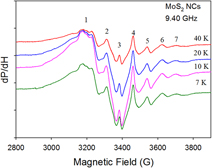Crossref Citations
This article has been cited by the following publications. This list is generated based on data provided by
Crossref.
Martinez, L. M.
Delgado, J. A.
Saiz, C. L.
Cosio, A.
Wu, Y.
Villagrán, D.
Gandha, K.
Karthik, C.
Nlebedim, I. C.
and
Singamaneni, S. R.
2018.
Magnetic and electrocatalytic properties of transition metal doped MoS2 nanocrystals.
Journal of Applied Physics,
Vol. 124,
Issue. 15,
Stesmans, A.
Schoenaers, B.
and
Afanas’ev, V. V.
2020.
Variations of paramagnetic defects and dopants in geo-MoS2 from diverse localities probed by ESR.
The Journal of Chemical Physics,
Vol. 152,
Issue. 23,
Martinez, L. M.
Iturriaga, H.
Olmos, R.
Shao, L.
Liu, Y.
Mai, Thuc T.
Petrovic, C.
Hight Walker, Angela R.
and
Singamaneni, S. R.
2020.
Enhanced magnetization in proton irradiated Mn3Si2Te6 van der Waals crystals.
Applied Physics Letters,
Vol. 116,
Issue. 17,
Zheng, Zhaoqiang
Yao, Jiandong
Li, Jingbo
and
Yang, Guowei
2020.
Non-layered 2D materials toward advanced photoelectric devices: progress and prospects.
Materials Horizons,
Vol. 7,
Issue. 9,
p.
2185.
Sanikop, Rohini
and
Sudakar, C.
2020.
Tailoring Magnetically Active Defect Sites in MoS2 Nanosheets for Spintronics Applications.
ACS Applied Nano Materials,
Vol. 3,
Issue. 1,
p.
576.
Sanikop, Rohini
Gautam, Sanjeev
Chae, Keun Hwa
and
Sudakar, C.
2021.
Robust ferromagnetism in Mn and Co doped 2D-MoS2 nanosheets: Dopant and phase segregation effects.
Journal of Magnetism and Magnetic Materials,
Vol. 537,
Issue. ,
p.
168226.
Strachan, Jyah
Masters, Anthony F.
and
Maschmeyer, Thomas
2021.
Critical review: hydrothermal synthesis of 1T-MoS2 – an important route to a promising material.
Journal of Materials Chemistry A,
Vol. 9,
Issue. 15,
p.
9451.
Shaikh, Naznin
Mukhopadhyay, Indrajit
and
Ray, Abhijit
2022.
Hydrothermally grown MoS2 nanosheets under non-equilibrium condition and its electrocatalytic hydrogen evolution performance.
Journal of Materials Research,
Vol. 37,
Issue. 11,
p.
1892.
Shi, Jinyan
Yang, Le
Zhang, Jie
Wang, Zejin
Zhu, Wenbo
Wang, Ying
and
Zou, Zhigang
2022.
Dual MOF‐Derived MoS2/CdS Photocatalysts with Rich Sulfur Vacancies for Efficient Hydrogen Evolution Reaction.
Chemistry – A European Journal,
Vol. 28,
Issue. 64,
Zhan, Wenqi
Zhai, Xingwu
Li, Yuhuan
Wang, Mei
Wang, Hang
Wu, Liang
Tang, Xinfeng
Zhang, Hongjun
Ye, Bangjiao
Tang, Kaibin
Wang, Gongming
and
Zhou, Min
2024.
Regulating Local Atomic Environment around Vacancies for Efficient Hydrogen Evolution.
ACS Nano,
Vol. 18,
Issue. 14,
p.
10312.
Khamrui, Sudipta
Bharti, Kamini
Goldfarb, Daniella
Das, Tilak
and
Banerjee, Debamalya
2024.
Exploring spin multiplicity in MoS2.
Nanoscale,
Vol. 16,
Issue. 46,
p.
21482.



